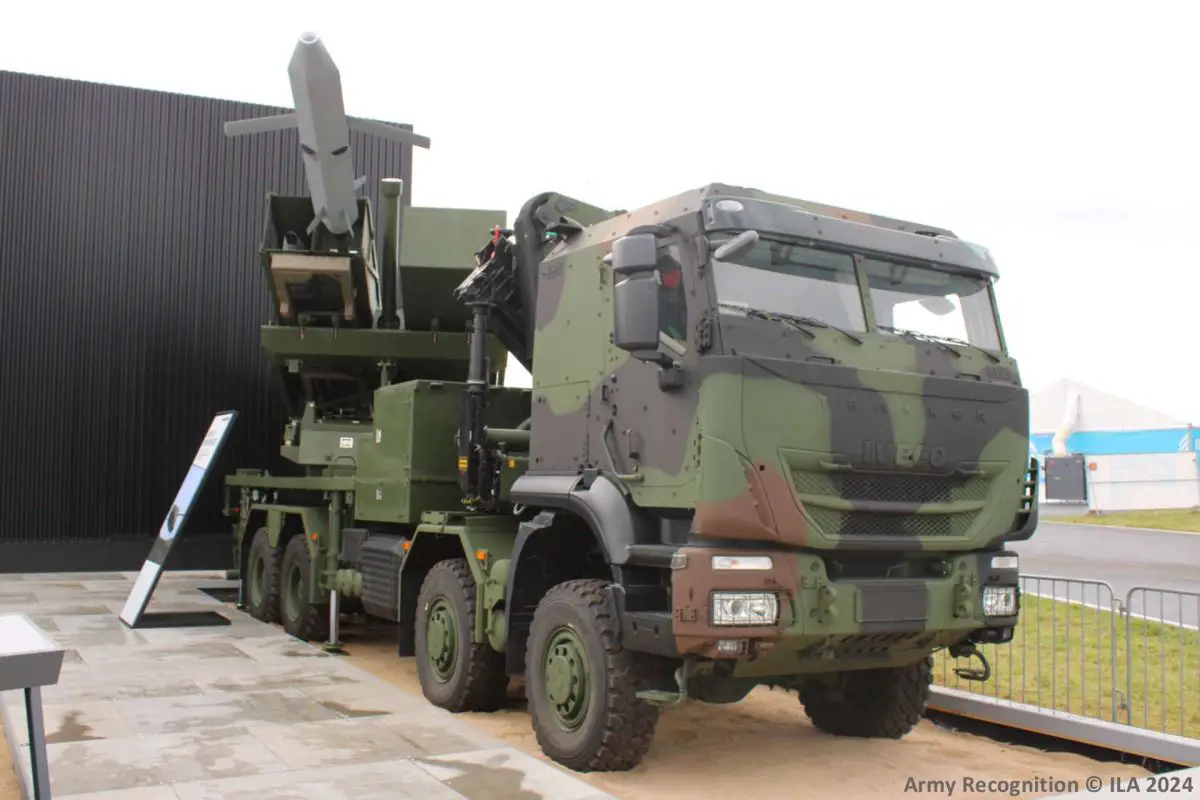Breaking news
Future EuroPULS multiple launch rocket system to reach targets 500km away with JFS-M missiles.
At the International Aviation Exhibition (ILA) 2024 in Berlin, MBDA Deutschland introduced several concepts of offensive and defensive weapon systems. A key presentation was the prototype of the EuroPULS multiple launch rocket system in its German configuration, mounted on an Iveco Trakker GTF3 8×8 truck. This prototype highlighted the potential for the EuroPULS to integrate the Joint Fire Support Missile (JFS-M) cruise missile, which has a range of nearly 500 kilometers.
Follow Army Recognition on Google News at this link

The prototype of the EuroPULS multiple launch rocket system, mounted on an Iveco Trakker GTF3 8×8 truck, highlighted the potential for this MLRS to integrate the Joint Fire Support Missile (JFS-M) cruise missile, which has a range of nearly 500 kilometers. (Picture source: Army Recognition)
The EuroPULS artillery system, developed by KNDS and Elbit Systems through a partnership established at the DSEI 2023 exhibition, is designed for scalability and flexibility, addressing various operational needs, as evidenced by the conflict in Ukraine. Unlike traditional multiple launch rocket systems (MLRS) that use proprietary ammunition, the EuroPULS system can utilize a broad spectrum of munitions from different suppliers, making it adaptable to diverse mission requirements. This feature aims to alleviate ammunition shortages and allows the system to keep pace with technological advancements.
Manufacturing of the EuroPULS will take place in Germany, with KNDS responsible for system integration. The system's design supports integration into various chassis types to meet different operational needs. For the German Bundeswehr, it is mounted on the Iveco Trakker GTF3 8×8, a configuration displayed during the ILA 2024 exhibition. The system is also compatible with other platforms such as the Scania Gryphus 8×8, Rheinmetall HX, Tatra 6×6, and potentially BAE Systems tracked platforms.
The EuroPULS features autonomous reloading capabilities, minimizing the need for additional support vehicles and enhancing operational flexibility. The Fire Control System (FCS) of the EuroPULS incorporates elements from the Boxer RCH155 self-propelled howitzer and is ITAR-free, facilitating connection to any fire direction center.
An ITAR-free system offers several practical benefits. It avoids the strict export controls of the International Traffic in Arms Regulations, providing greater export flexibility and reducing bureaucratic hurdles. This simplifies the approval process for international sales, reducing delays and administrative burdens. Additionally, ITAR-free systems can access a wider market, including countries with restrictive import policies against ITAR-regulated items, lowering compliance costs. These factors contribute to more competitive pricing and faster delivery times, making such systems more appealing to international buyers and defense contractors.
Strategically, the EuroPULS is intended to replace older systems like the M270 MLRS, known in Germany as MARS 2 and in France as LRU, aligning with broader efforts to modernize military capabilities across Europe. The first EuroPULS demonstrator was presented in 2023, with prototypes expected to be ready by Q3 2024. Firing tests are scheduled before the end of the year, with full operational availability anticipated by 2027, contingent on orders.

The Joint Fire Support Missile (JFSM) ground-launched cruise missile features an image-based and GPS navigation system, enabling precise 3D flight path planning and time-over-target coordination. (Picture source: Army Recognition)
The EuroPULS system includes two launcher pods that can be loaded with various types of ammunition, ensuring flexibility at the single-launcher level. These munitions include short-range Accular 122 and 160 mm guided rockets with ranges of 35 km and 40 km, respectively, and medium-range EXTRA rockets with a range of 150 km. It can also deploy Predator Hawk rockets for precision strikes up to 300 km, SkyStriker loitering munitions reaching 100 km, and Saab's Ground Launched Small Diameter Bomb (GLSDB) with a 150 km range. Additionally, it can fire Kongsberg's Naval Strike Missile (NSM) with a range exceeding 250 km, and MBDA’s Joint Fire Support Missile (JFSM) and 3SM Tyrfing missiles with ranges of up to 500 km.
Development of the JFS-M ground-launched cruise missile has been ongoing since at least March 2021. In November 2022, MBDA Deutschland signed a memorandum of understanding with ESG and Krauss-Maffei Wegmann to offer the JFS-M for the Bundeswehr's Future Long-Range Indirect Fire System project. This missile, first unveiled at the ILA 2022 show in Berlin, is based on the RC100 small remote carrier, a design that MBDA is developing as part of the Future Combat Air System project involving France, Germany, and Spain.
The JFS-M measures 2.6 meters in length, has a wingspan of 1.5 meters, and weighs approximately 300 kilograms. It uses a booster and turbojet engine for propulsion, achieving speeds between Mach 0.4 and Mach 0.9, reaching targets up to 499 km. The missile is equipped with an 80-kilogram multi-effector or scalable high-explosive warhead.
The JFS-M can be configured for various roles including active weapon use, reconnaissance, electronic warfare (both active and passive), and training. It features robust image-based and GPS navigation, enabling precise 3D flight path planning and time-over-target coordination. The missile's low-signature hull and ability to fly low and follow terrain contours enhance its ability to evade detection and engagement by enemy forces.
Recent conflicts, such as the one in Ukraine, have highlighted the limitations of current artillery systems when facing modern air defense suppression and electromagnetic spectrum techniques. Artificial intelligence is utilized in the JFS-M for automatic target detection and identification, supporting the engagement process and improving target acquisition accuracy. The missile allows for flexible mission planning, including navigation around occupied airspace to avoid friendly forces, enhancing operational safety and efficiency.

The EuroPULS system includes two launcher pods that can be loaded with various types of ammunition, ensuring flexibility at the single-launcher level for short, medium, and long ranges. (Picture source: Army Recognition)


























